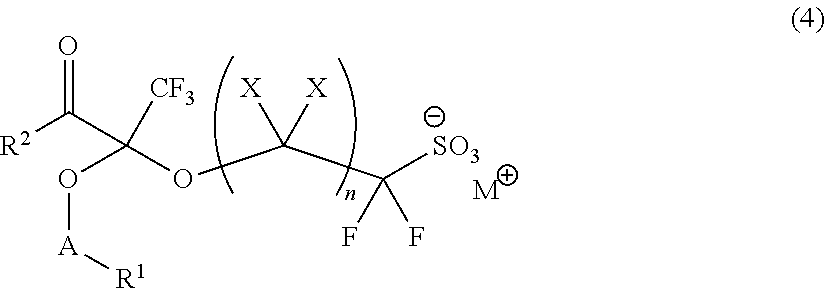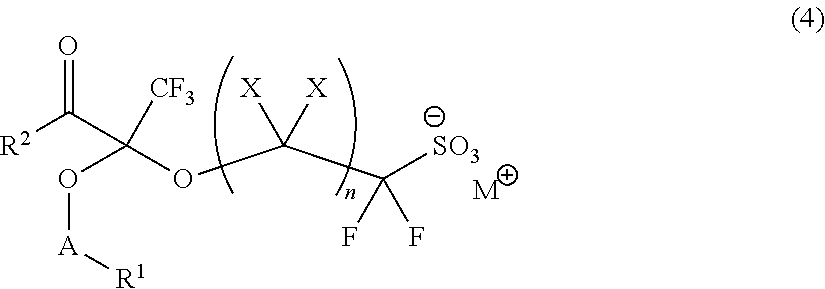Fluorine-Containing Sulfonic Acid Salts, Photo-Acid Generator And Resist Composition And Pattern Formation Method Utilizing Same
- Summary
- Abstract
- Description
- Claims
- Application Information
AI Technical Summary
Benefits of technology
Problems solved by technology
Method used
Image
Examples
synthesis example 1
Triphenylsulfonium 2-[1-Ethoxycarbonyl-1-(1-adamantane)carbonyloxy-2,2,2-trifluoroethoxy]-1,1-difluoroethanesulfonate
[0271]
[0272]First, 5.0 g of triphenylsulfonium 2-hydroxy-1,1-difluoroethanesulfonate in white solid form (purity: 62.2%; equivalent to 7.3 mmol) was dissolved by stirring into 35 g of chloroform. The resulting solution was admixed with 1.46 g (equivalent to 8.55 mmol) of ethyltrifluoromethyl pyruvate and subjected to reaction for 3 hours at room temperature. This reaction solution was concentrated under a reduced pressure, followed by adding thereto 26.5 g of acetonitrile to dissolve the reaction intermediate by stirring. The dissolved solution was admixed with 1.56 g (equivalent to 9.56 mmol) of 1-adamantanecarboxylic acid chloride and 1.06 g (equivalent to 10.47 mmol) of triethylamine. The resulting mixture was stirred for 3 hours at room temperature and subjected to separation with the addition of 30 g of chloroform and 50 g of ion-exchanged water. The separated or...
synthesis example 2
Triphenylsulfonium 4-[1-Ethoxycarbonyl-1-(1-adamantane)carbonyloxy-2,2,2-trifluoroethoxy]-1,1,2,2-tetrafluorobutanesulfonate]
[0275]
[0276]In a 1-L side-arm flask, 317.5 g of 33 mass % acetonitrile solution of triphenylsulfonium 4-hydroxy-1,1,2,2-tetrafluorobutanesulfonate (solute: 104.7 g, equivalent to 0.21 mol) was placed and admixed with 49.7 g (equivalent to 0.29 mol) of ethyltrifluoromethyl pyruvate. The resulting solution was subjected to reaction for 3 hours at room temperature. This reaction was sampled and analyzed by 19F NMR to confirm that the triphenylsulfonium 4-hydroxy-1,1,2,2-tetrafluorobutanesulfonate as the raw material was consumed. Subsequently, 46.1 g (equivalent to 0.28 mol) of 1-adamantanecarboxylic acid chloride and 0.47 g (equivalent to 0.0039 mol) of dimethylaminopyridine were added to the reaction solution and mixed by stirring. Further, a solution of 29.6 g (equivalent to 0.29 mol) of triethylamine in 100 g of acetonitrile was slowly added through a droppin...
synthesis example 3
Triphenylsulfonium 6-[1-Ethoxycarbonyl-1-(1-adamantane)carbonyloxy-2,2,2-trifluoroethoxy]-1,1,2,2-tetrafluorohexanesulfonate
[0279]
[0280]In a 500-mL side-arm flask, 146.4 g of 33 mass % acetonitrile solution of triphenylsulfonium 6-hydroxy-1,1,2,2-tetrafluorohexanesulfonate (solute: 48.3 g, equivalent to 56.9 mmol) was placed and admixed with 11.6 g (equivalent to 68.3 mmol) of ethyltrifluoromethyl pyruvate. The resulting solution was subjected to reaction for 3 hours at room temperature. This reaction was sampled and analyzed by 19F NMR to confirm that the triphenylsulfonium 6-hydroxy-1,1,2,2-tetrafluorohexanesulfonate as the raw material was consumed. Subsequently, 14.1 g (equivalent to 71.1 mmol) of 1-adamantanecarboxylic acid chloride and 0.14 g (equivalent to 1.14mmol) of dimethylaminopyridine were added to the reaction solution and mixed by stirring. Further, a solution of 7.43 g (equivalent to 73.4 mmol) of triethylamine in 30 g of acetonitrile was slowly added through a drop...
PUM
| Property | Measurement | Unit |
|---|---|---|
| Nanoscale particle size | aaaaa | aaaaa |
| Nanoscale particle size | aaaaa | aaaaa |
| Mass | aaaaa | aaaaa |
Abstract
Description
Claims
Application Information
 Login to View More
Login to View More - R&D
- Intellectual Property
- Life Sciences
- Materials
- Tech Scout
- Unparalleled Data Quality
- Higher Quality Content
- 60% Fewer Hallucinations
Browse by: Latest US Patents, China's latest patents, Technical Efficacy Thesaurus, Application Domain, Technology Topic, Popular Technical Reports.
© 2025 PatSnap. All rights reserved.Legal|Privacy policy|Modern Slavery Act Transparency Statement|Sitemap|About US| Contact US: help@patsnap.com



